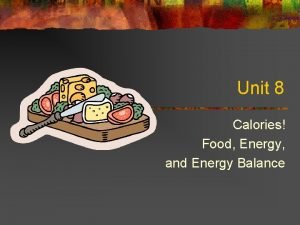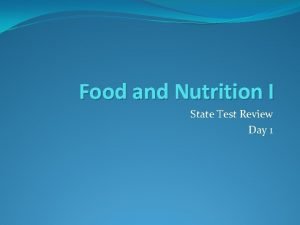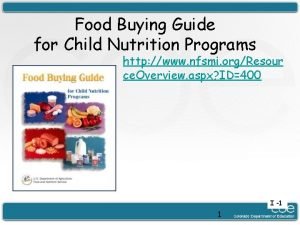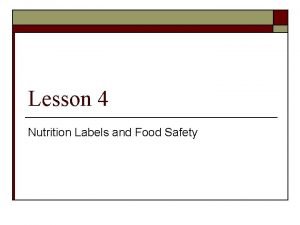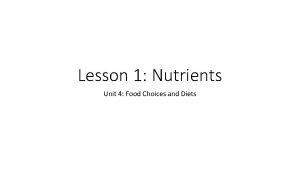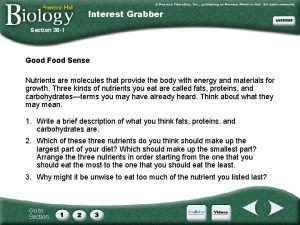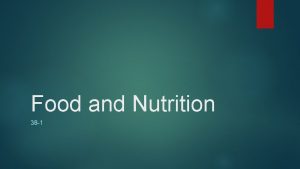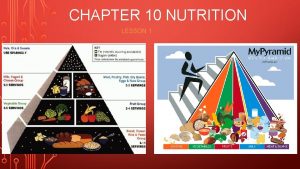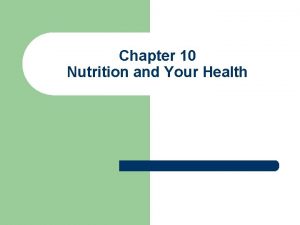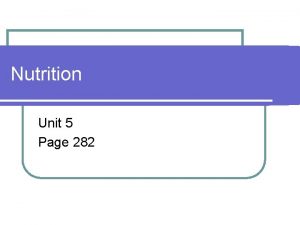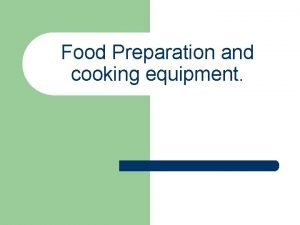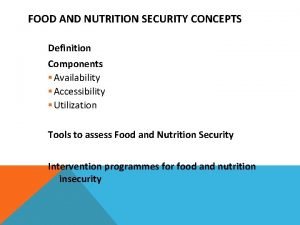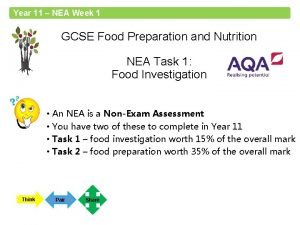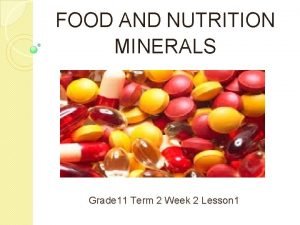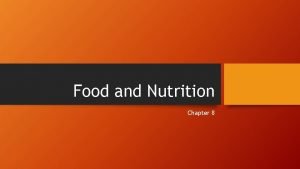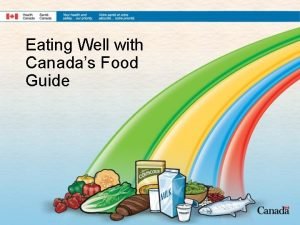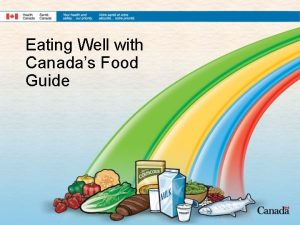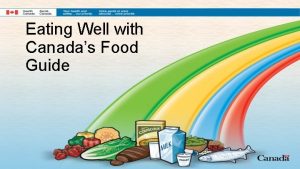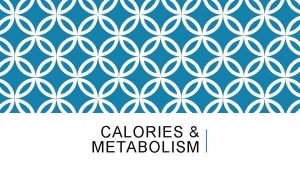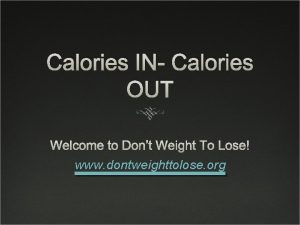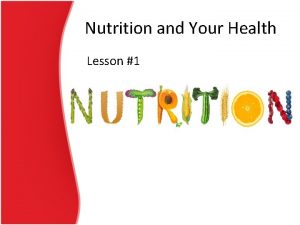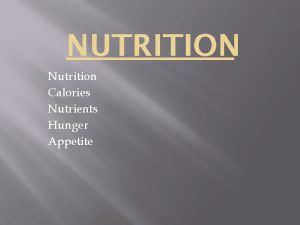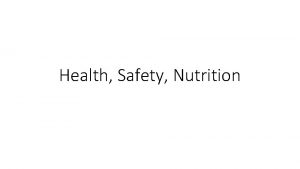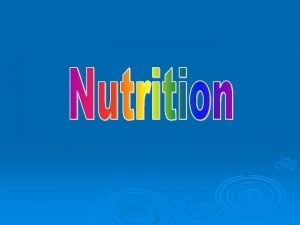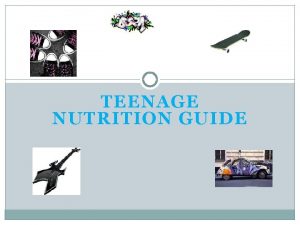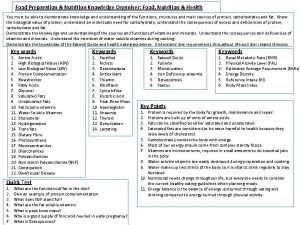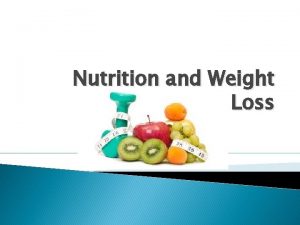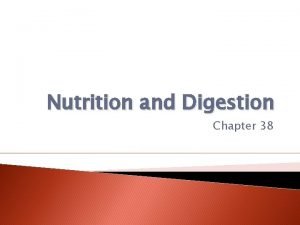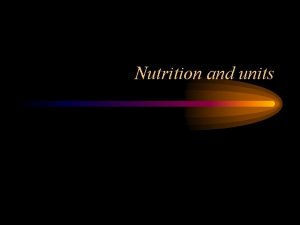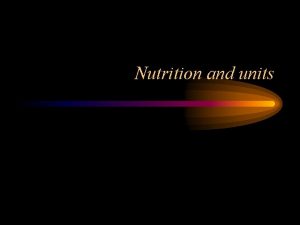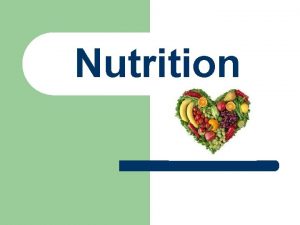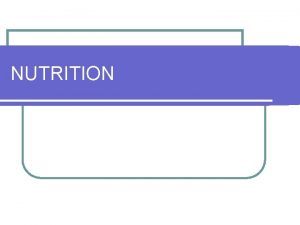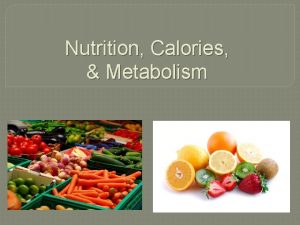Nutrition Calories and Canadas New Food Guide Review





































- Slides: 37

Nutrition, Calories and Canada’s New Food Guide

Review of Nutrition All the foods we eat are divided into 2 categories: Macronutrients Micronutrients

Macronutrients 1. Carbohydrates – are a source of calories from sugars and starches that fuel your body. Your primary energy source. Eg. Fruits, vegetables, grains, wheat 1 gram = 4. 1 calories of energy

Macronutrients cont… B. Fats – fats are a source of energy that used during low-level and long-term activity There are 3 types of fats: Saturated fats – bad fats come from animals Unsaturated fats – good fats – come from plants Trans fats – made by man – very bad 1 gram = 9. 3 calories

Saturated fats Unsaturated fats Trans fats

C. Proteins – are essential for building and repairing muscles, red blood cells, hair, and for synthesizing hormones Proteins can be used for energy if carbohydrates aren’t available E. g. fish, poultry, meats, tofu, and beans 1 gram = 4. 3 calories

Micronutrients A. Vitamins– regulate chemical reactions within the body They include: Vitamin A, B complex (B 1, B 2, B 3, B 6, B 12) C, D, E, K Vitamins A, D, E, K are fat soluble vitamins (stored in fat cells) Vitamins B complex and C are water soluble. Vitamins are not a source of energy.

B. Minerals – elements obtained from foods that combine in many ways to form structures of the body (calcium forms bones) and regular body processes (iron in red blood cells transports oxygen) Some other minerals include magnesium, phosphorus, sodium, potassium, chromium and zinc. Minerals do not provide energy

C. Water – an essential substance that makes up about 60 -75% of your weight Water stabilizes your body temperature, carries nutrients to and waste away from your cells, and is needed for cells to function Water does not provide energy.

Understanding Calories Calorie (C) - the amount of energy needed to raise one kilogram of water by one degree Celsius. This is the definition used dealing with food calorie (c) – the amount of energy needed to raise one gram of water by one degree Celsius

Calories Continued Macronutrients contain a specific amount of energy in each gram of food. Carbohydrates = 4 Calories / gram Protein = 4 Calories / gram Fat = 9 Calories / gram Alcohol = 7 Calories / gram

Basil Metabolic Rate The minimal caloric requirement needed to sustain life in a resting individual This is the amount of energy your body would burn if you slept all day. Men BMR = (10 × weight in kg) + (6. 25 × height in cm) - (5 × age in years) + 5 Women BMR = (10 × weight in kg) + (6. 25 × height in cm) - (5 × age in years) - 161 H = height in meters W = weight in kilograms A = age

Calculate your BMR Conversions: Pounds to Kilograms (divide pounds by 2. 2) Inches to cm (multiply inches by 2. 54) BMR = (10 × _____ kg) + (6. 25 × __ cm) - (5 × ____age) + 5 =____

Basil Metabolic Rate cont… Your BMR is higher or will increase if… 1. 2. 3. 4. 5. 6. You are taller You are pregnant You have a fever You have more muscle mass Stress Male Your BMR will be lower or will decrease if… 1. 2. 3. 4. As you get older If you are fasting Malnutrition If you have a decrease in muscle mass

Basil Metabolic Rate cont… BMR establishes an important baseline for a weight control program using diet and exercise It is possible to gain a general guide to the daily caloric need in sustaining one’s current body weight The body cannot store protein or carbohydrates so excess of these macronutrients is stored as fat Lifestyle Example PAL Calculation Sedentary or light activity Office worker getting little or no exercise 1. 53 BMR x 1. 53 Active or moderately active Construction worker or person running one hour daily 1. 76 BMR x 1. 76 Vigorously active Agricultural worker (non mechanized) or person swimming two hours daily 2. 25 BMR x 2. 25

Calories and the Energy Equation Energy equation = Calories in – Calories out (food and beverages) (physical activity, body functions)

Estimated Energy Requirement (EER) An EER is defined as the average dietary energy intake that is predicted to maintain energy balance in healthy, normal weight individuals of a defined age, gender, weight, height, and level of physical activity consistent with good health. In children and pregnant and lactating women, the EER includes the needs associated with growth or secretion of milk at rates consistent with good health.

Estimated Energy Requirements (EER) Estimated Energy Requirement (kcal/day) = Total Energy Expenditure + Energy Deposition Boys 9 - 18 EER = 88. 5 - (61. 9 x age [y]) + PA x { (26. 7 x weight [kg]) + (903 x height [m]) } + 25 Girls 9 – 18 EER = 135. 3 - (30. 8 x age [y]) + PA x { (10. 0 x weight [kg]) + (934 x height [m]) } + 25

Calculating your EER You may need a few conversions Height Total inches x 2. 54 = height in cm Ex 6 feet 1 inch = 73 inches x 2. 54 = 185. 4 cm Weight Total Pounds x 0. 453 = weight in kg Ex 165 lbs = 165 x 0. 453 = 74. 7 kg

Physical Activity Coefficients (PA values) for use in EER equations Low Active (PAL 1. 6 - Very Active (PAL 1. 9 -2. 5) Sedentary (PAL 1. 4 -1. 59) 1. 89) 1. 0 -1. 39) Typical daily living activities PLUS At least Typical daily living activities PLUS At 60 minutes of daily living activities PLUS 30 - 60 least 60 minutes moderate activity PLUS (e. g. , minutes of daily moderate An additional 60 household moderate activity minutes of vigorous tasks, walking activity (ex. activity or 120 minutes of to the bus) walking at 5 -7 moderate activity km/h) Boys 3 - 18 y Girls 3 - 18 y Men 19 y + Women 19 y + 1. 00 1. 13 1. 26 1. 42 1. 00 1. 16 1. 31 1. 56 1. 00 1. 11 1. 25 1. 48 1. 00 1. 12 1. 27 1. 45

Body Mass Index Used to assess the extent to which individuals are balancing the energy equation Ratio of a person’s weight in kilograms to the square of his or height in meters Weight (kg) Height² (m) CONVERSIONS: 2. 2 lbs = 1 kg 1 inch = 2. 5 cm 100 cm = 1 m

Body Mass Index cont… A score of 18. 5 to 24. 9 is considered normal A score of 25. 0 to 29. 9 is considered overweight A score of greater than 30 is considered obese

Body Mass Index cont… In most cases, BMI correlates well with increased risks of disease, particularly cardiovascular, pancreatic, and kidney disease However, it does not distinguish between fat and excess muscle E. g. athletes such as wrestlers and football players would record high BMI’s but this may have no relation to their overall health and mortality

Canada’s Old Food Guides 1942

1944

1949

1961

1977

1982

1992

2007

Canada’s Food Guide

Canada’s Food Guide Eat plenty of vegetables and fruits, whole grain foods and protein foods. Choose protein foods that come from plants more often.

Canada’s Food Guide Choose foods with healthy fats instead of saturated fat Limit highly processed foods. If you choose these foods, eat them less often and in small amounts.

Canada’s Food Guide Prepare meals and snacks using ingredients that have little to no added sodium, sugars or saturated fat Choose healthier menu options when eating out

Canada’s Food Guide Make water your drink of choice Replace sugary drinks with water Use food labels Be aware that food marketing can influence your choices

Complete the questions on the handout
 Junk milk
Junk milk Biobeyond unit 8 nutrition lab counting calories
Biobeyond unit 8 nutrition lab counting calories Food and nutrition 2 state test review
Food and nutrition 2 state test review Food buying guide
Food buying guide Bianchi new age white
Bianchi new age white Temperatura en las cañadas del teide
Temperatura en las cañadas del teide Canadas landforms
Canadas landforms 90 of the canadian population lives within
90 of the canadian population lives within Whats canadas longest river
Whats canadas longest river Unit 5 food national geographic
Unit 5 food national geographic Canadas head of state
Canadas head of state What is canada's economic system
What is canada's economic system Electromagnetismo
Electromagnetismo Physical regions in canada
Physical regions in canada Canadas climate
Canadas climate Burning calories part/gland and the effect
Burning calories part/gland and the effect British nutrition foundation eatwell guide
British nutrition foundation eatwell guide Gcse food tech high skill dishes
Gcse food tech high skill dishes Lesson 4 nutrition labels and food safety
Lesson 4 nutrition labels and food safety Food and nutrition unit 4
Food and nutrition unit 4 38-2 the process of digestion
38-2 the process of digestion Rda food label
Rda food label 38-1 food and nutrition
38-1 food and nutrition Chapter 10 nutrition for health lesson 1 answer key
Chapter 10 nutrition for health lesson 1 answer key Chapter 10 lesson 4 nutrition labels and food safety
Chapter 10 lesson 4 nutrition labels and food safety Usda food and nutrition service
Usda food and nutrition service Food and nutrition unit 5
Food and nutrition unit 5 Labour saving devices in the kitchen
Labour saving devices in the kitchen Define nutrition security
Define nutrition security Section 38-1 food and nutrition
Section 38-1 food and nutrition Nea 1
Nea 1 Food and nutrition grade 11
Food and nutrition grade 11 Chapter 8 food and nutrition
Chapter 8 food and nutrition Food and nutrition expo
Food and nutrition expo Unit 2 food food food
Unit 2 food food food Food chain food chain food chain
Food chain food chain food chain Tls weight management
Tls weight management A particular panda consumes 1944 calories
A particular panda consumes 1944 calories

